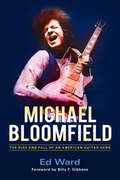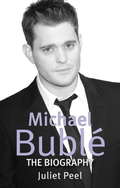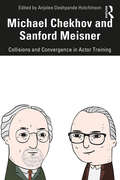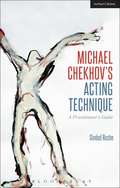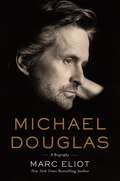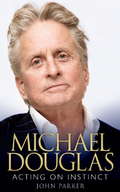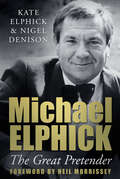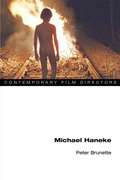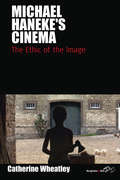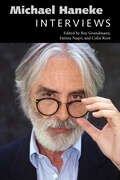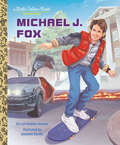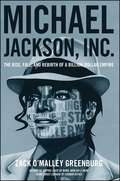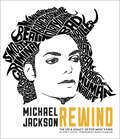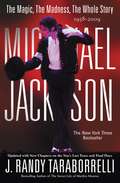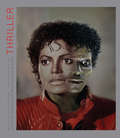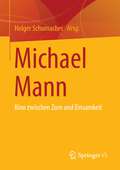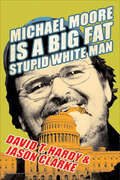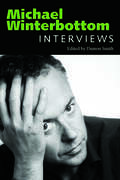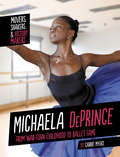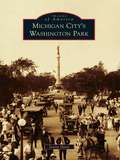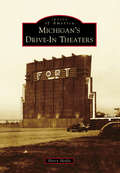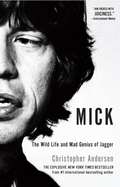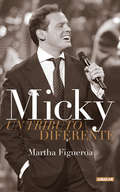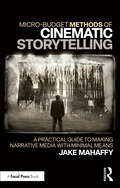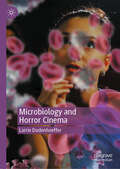- Table View
- List View
Michael Bloomfield: The Rise and Fall of an American Guitar Hero
by Billy Gibbons Ed WardThis is the definitive biography of the legendary guitarist whom Muddy Waters and B. B. King held in high esteem and who created the prototype for Clapton, Hendrix, Page, and those who followed. Bloomfield was a member of the Paul Butterfield Blues Band, which inspired a generation of white blues players; he played with Bob Dylan in the mid-1960s, when his guitar was a central component of Dylan's new rock sound on "Like a Rolling Stone." He then founded the Electric Flag, recorded Super Session with Al Kooper, backed Janis Joplin, and released at least twenty other albums despite debilitating substance abuse. This book, based on extensive interviews with Bloomfield himself and with those who knew him best, and including an extensive discography and Bloomfield's memorable 1968 Rolling Stone interview, is an intimate portrait of one of the pioneers of rock guitar.
Michael Buble: The biography
by Juliet PeelMichael Bublé is an international singing sensation. Since his debut in 2003, he has sold 18 million albums, won numerous awards (including a Grammy), reached the top 10 in the UK charts with his first album, 'Michael Bublé', and the top 50 of the Billboard 200 album charts for the same CD. His second album, 'It's Time', was more successful still, debuting at number 4 in the UK charts, and his song 'Home' was a UK number one. His performances and concerts worldwide have been sell outs, while he has cultivated a huge and loyal fanbase. Of Italian origin, and born into a family of fishermen in Canada, Michael was heavily influenced by his grandfather, whom he credited with introducing him to the kind of music he would make his own - Frank Sinatra, Ray Charles, Dean Martin and Elvis, to name but a few. His popularity continues to grow, and this comprehensive and definitive biography charts his fascinating and phenomenal success story.
Michael Chekhov and Sanford Meisner: Collisions and Convergence in Actor Training
by Anjalee Deshpande HutchinsonMichael Chekhov and Sanford Meisner: Collisions and Convergence in Actor Training offers a comprehensive analysis of the Sanford Meisner Acting Technique in comparison to the Michael Chekhov Acting Technique. This compilation reveals the connections as well as the contradictions between these two very different approaches, while highlighting meaningful bridges and offering in-depth essays from a variety of sources, including master teachers with years of experience and new and rising stars in the field. The authors provide philosophical arguments on actor training, innovative approaches to methodology, and explorations into integration, as well as practical methods of application for the classroom or rehearsal room, or scaffolded into a curriculum. Michael Chekhov and Sanford Meisner: Collisions and Convergence in Actor Training is an excellent resource for professors teaching Introductory, Intermediate or Advanced Acting Technique as well as acting program directors and department chairs seeking new, impactful research on actor training.
Michael Chekhov’s Acting Technique: A Practitioner’s Guide (Performance Books)
by Sinéad RusheIntended for actors, directors, teachers and researchers, this book offers an exceptionally clear and thorough introduction to the renowned acting technique developed by Michael Chekhov. Sinéad Rushe's book provides a complete overview of the whole method, and includes illuminating explanations of its principles, as well as a wide range of practical exercises that illustrate, step by step, how they can be applied to dramatic texts. Part One provides an outline of the ideas that underpin the work, which help to prepare practitioners to become responsive and receptive, and to awaken their imagination. Part Two charts a journey through the foundational psychophysical exercises that can both orient an actor's training routine and be applied directly to the development of a role. Part Three focuses on more specific and elaborate methods of scene work, characterisation and the art of transformation.
Michael Douglas: A Biography
by Marc EliotThrough determination, inventiveness, and charisma, Michael Douglas emerged from the long shadow cast by his movie-legend father, Kirk Douglas, to become his own man and one of the film industry's most formi dable players. Overcoming the curse of failure that haunts the sons and daughters of Hollywood celebrities, Michael became a sensation when he successfully brought One Flew Over the Cuckoo's Nest, starring his friend Jack Nicholson, to the screen after numerous setbacks, including his father's own failed attempts to make it happen. This 1975 box-office phenomenon won Michael his first Oscar (the film won five total, including Best Picture), an award Kirk hadn't won at the time, and solidified the turbulent, competitive father-son relationship that would shape Michael's career and personal life. In the decades that followed, Michael established a reputation for taking chances on new talent and proj ects by producing and starring in the hugely successful Romancing the Stone and Jewel of the Nile movies, while cultivating a multifaceted acting persona edgy, rebel lious, and a little dark in such films as Wall Street, Fatal Attraction, Basic Instinct, and Disclosure. Yet as his career thrived, Michael's personal life floundered, with an unhappy and tumultuous first mar riage, rumors of infidelity (especially with leading ladies such as Kathleen Turner), and a headline-grabbing stint in rehab. Rocked by a series of tragedies, including Kirk's strokes, his son Cameron's incarceration, and his own fight against throat cancer, Michael has emerged trium phant, healthy, and happy in his marriage to Catherine Zeta-Jones, a Welsh actress twenty-five years his junior, and their new young family. In Michael Douglas, Marc Eliot brings into sharp fo cus this incredible career, complicated personal life, and legendary Hollywood family. Eliot's fascinating portrait of the lows and remarkable highs in Michael's life in cluding the thorny yet influential relationship with his father breaks boundaries in understanding the life and work of a true American film star.
Michael Douglas: Acting on Instinct
by John ParkerIn the shadow of his father Kirk's overpowering fame, Michael Douglas forged a career for himself and became recognised in his own right as an award-winning actor and producer. But fame has taken its toll on Michael's personal life. His struggles with sexual addiction, his treatment for alcoholism and drug dependency and the break-up of his first marriage show another side to Michael's success. In 2010, his troubled past came back to haunt him when Cameron, his eldest son, was sentenced to five years in prison for drug dealing. Yet, despite a rocky road, Michael has found happiness later in life. His marriage to Catherine Zeta Jones meant a second shot at fatherhood and gave him strength following a devastating diagnosis of advanced throat cancer at the age of 65. This is the compelling and remarkable story of a Hollywood son who waged a battle against the odds to achieve his fame and fortune, and has kept on fighting with every challenge he faces.
Michael Elphick: The Great Pretender
by Neil Morrissey Kate Elphick Nigel DenisonMichael Elphick was a young electrician working at the Chichester Theatre when he was discovered by Laurence Olivier, who arranged for him to join the Central School of Drama. It was here where he met Bruce Robinson, who would later cast him in one of the most popular British films of all time – Withnail and I. Elphick’s illustrious career also included major supporting roles in films such as Quadrophenia, The Elephant Man, Gorky Park and Dennis Potter’s Blue Remembered Hills. On television, there was Private Schultz and Boon, which gave his acolyte and friend, Neil Morrissey, his first starring role. One of his characters’ owned houses in Coronation Street whilst another wooed Peggy Mitchell in Eastenders. However, Elphick’s private life was every bit as varied as his acting career. Racked by alcoholism and devastated by the early death of his partner, Julia, Elphick died at the age of 55. And yet, his friends and family will always remember his hugely humorous personality, and everyone he met was left with a ‘Mike Elphick story’...
Michael Haneke (Contemporary Film Directors)
by Peter BrunetteIn this book, Peter Brunette analyzes the theatrical releases of Austrian film director Michael Haneke, including The White Ribbon, winner of the 2009 Palme d'Or at the Cannes Film Festival. Perhaps best known to U.S. audiences for Caché, The Piano Teacher, and his remake of his own disturbing Funny Games, Haneke has consistently challenged critics and film viewers to consider their own responsibility for what they watch when they seek to be "merely" entertained by such studio-produced Hollywood thrillers. Brunette highlights Haneke's brilliant use of uncompromising visual and aural techniques to express complex themes. His most recent films contain what has become his hallmark: a moment of violence or shock that is not intended to be exploitative, but that nevertheless goes beyond the conventional boundaries of most art cinema. Lauded for graphically revealing the powerful influence of contemporary media on social behavior, his films offer a chilling critique of contemporary consumer society. Brunette discusses Haneke's major releases in English, French, and German, including the film that first brought him to international attention, Benny's Video. The first full-length study of Haneke's work in any language, this book also includes an interview with the director that explores his motivations and methods.
Michael Haneke's Cinema
by Catherine WheatleyExisting critical traditions fail to fully account for the impact of Austrian director, and 2009 Cannes Palm d'Or winner, Michael Haneke's films, situated as they are between intellectual projects and popular entertainments. In this first English-language introduction to, and critical analysis of, his work, each of Haneke's eight feature films are considered in detail. Particular attention is given to what the author terms Michael Haneke's 'ethical cinema' and the unique impact of these films upon their audiences. Drawing on the moral philosophy of Immanuel Kant and Stanley Cavell, Catherine Wheatley, introduces a new way of marrying film and moral philosophy, which explicitly examines the ethics of the film viewing experience. Haneke's films offer the viewer great freedom whilst simultaneously imposing a considerable burden of responsibility. How Haneke achieves this break with more conventional spectatorship models, and what its far-reaching implications are for film theory in general, constitute the principal subject of this book.
Michael Haneke: Interviews (Conversations with Filmmakers Series)
by Roy Grundmann, Fatima Naqvi, and Colin RootSpanning five decades and twenty-four films, director Michael Haneke’s career is one of the most significant in the history of European art cinema. However, critical reception has long lagged behind his output. By the time Haneke (b. 1942) emerged into the international spotlight as a cinematic visionary with the 1989 Cannes premiere of The Seventh Continent, he had worked in filmmaking for two decades, producing seven feature-length films. As many of his films aired solely on Austrian and German television, they remained unknown to audiences outside the German-speaking world until 2007, when the first comprehensive Haneke retrospective took place in the United States. Michael Haneke: Interviews presents some of Haneke’s most profound interviews to English speakers. The volume features seventeen articles, fourteen of which have been translated into English for the first time, and all of which provide a detailed, eloquent commentary on his films and worldview. This book represents the most extensive collection to date of interviews with the filmmaker, spanning his entire oeuvre—from his earliest television films to his so-called “Glaciation Trilogy” of the 1990s, from the notorious dark satire Funny Games to its similarly notorious 2007 Hollywood remake, and from his French films of the 2000s to his Oscar-winning drama, Amour, and his most recent feature, Happy End.
Michael J. Fox: A Little Golden Book Biography (Little Golden Book)
by Lori Haskins HouranGet inspired by Michael J. Fox, the beloved Back to the Future actor from Canada who is helping people all around the world, with this collectible Little Golden Book featuring full-color illustrations on every page!Michael moved to California—1,300 miles away from home—to be a Hollywood star!Actor Michael J. Fox is known for playing Alex P. Keaton on TV's Family Ties and Marty McFly in the Back to the Future movies. The talented actor became a determined activist after being diagnosed with Parkinson's Disease and starting a foundation to help find a cure. Michael J. Fox: A Little Golden Book Biography will inspire readers of all ages. Look for more Little Golden Book biographies:• Bruce Springsteen• Dwayne Johnson• Steve Martin• Zendaya• Harry Styles
Michael Jackson, Inc.
by Zack O'Malley GreenburgThe surprising rags-to-riches-to-rags-to-riches story of how Michael Jackson grew a billion-dollar business.Michael Jackson is known by many as the greatest entertainer of all time, but he was also a revolutionary when it came to business. In addition to famously buying the Beatles' publishing catalogue, Jackson was one of the first pop stars to launch his own clothing line, record label, sneakers, and video games--creating a fundamental shift in the monetization of fame and paving the way for entertainer-entrepreneurs like Jay Z and Diddy. All told, Jackson earned more than $1.1 billion in his solo career, and the assets he built in life have earned more than $700 million in the five years since his death--more than any other solo music act over that time. Michael Jackson, Inc. reveals the incredible rise, fall, and rise again of Michael Jackson's fortune--driven by the unmatched perfectionism of the King of Pop. Forbes senior editor Zack O'Malley Greenburg uncovers never-before-told stories from interviews with more than 100 people, including music industry veterans Berry Gordy, John Branca, and Walter Yetnikoff; artists 50 Cent, Sheryl Crow, and Jon Bon Jovi; and members of the Jackson family. Other insights come from court documents and Jackson's private notes, some of them previously unpublished. Through Greenburg's novelistic telling, a clear picture emerges of Jackson's early years, his rise to international superstardom, his decline--fueled by demons internal and external, as well as the dissolution of the team that helped him execute his best business moves--and, finally, his financial life after death. Underlying Jackson's unique history is the complex but universal tale of the effects of wealth and fame on the human psyche. A valuable case study for generations of entertainers to come and for anyone interested in show business, Michael Jackson, Inc. tells the story of a man whose financial feats, once obscured by his late-life travails, have become an enduring legacy.
Michael Jackson: The Life & Legacy of Pop Music's King
by Daryl EasleaRelive the incredible history of the King of Pop in reverse. Michael Jackson: Rewind charts the life to Michael from his tragic, unexpected passing to his childhood.By the time Michael Jackson passed away in 2009, he had sold an estimated 750 million records worldwide over his career. He had won 26 American Music Awards and 13 Grammy Awards as well as the Grammy Lifetime Achievement Award, and was ranked number three, after The Beatles and Elvis Presley, of best-selling music artists. Five years after his death, the net worth of his estate is more than 600 million dollars. He is, without a doubt, one of the most popular - and controversial - artists of all time. Now, for the first time ever, author Daryl Easlea will explore the life and history of Michael Jackson... in reverse. Starting with his tragic death and rewinding to his early hits with the Jackson 5 and life in Gary, Indiana, this is a complete illustrated history of the King of Pop: his genius, his life, and his demons. Loaded with over 300 images, a timeline of his life, a complete discography, and more, this is the must-have book for any Michael Jackson fan.
Michael Jackson: The Magic, The Madness, The Whole Story, 1958-2009
by J. Randy TaraborrelliAfter 30 years of interviews with the Jackson family, this book is a behind the scenes look.
Michael Jackson: The Making of "Thriller"
by Douglas KirklandMichael Jackson: The Making of "Thriller" is an illustrated tribute to the King of Pop and his groundbreaking music video, with never-before-seen photos of its creation. The book features over 200 exclusive, behind-the-scenes photographs of the artist on set during the 1983 production of the Grammy award winning video directed by John Landis. Considered to be the most successful project of all time, "Thriller" is beloved the world over, inspiring imitation and a cult-like following of millions of fans. Documenting the creation of the most popular and iconic music video of all time, this book celebrates the artist and his music at the top of his career. Famed photographer Douglas Kirkland and journalist Nancy Griffin were the only members of the media allowed on the set of the video. The resulting photos capture Jackson both in high performance mode and relaxing on the set and depict his transformation into the characters in the video as well capturing the public and private faces of Michael Jackson. Compelling, intimate photos of the artist are accompanied by interviews and quotes from musicians and celebrities, including Sir Paul McCartney, Diddy, Beyonce, Steven Spielberg and many more. With a holographic cover that, when tilted, transforms the artist into his zombie character, the book is an impressive gift to be treasured by fans and music lovers everywhere.
Michael Mann: Kino zwischen Zorn und Einsamkeit
by Holger SchumacherZum ersten Mal widmen sich zehn deutschsprachige Wissenschaftler mit unterschiedlichen Forschungsschwerpunkten dem Gesamtwerk Michael Manns. Dabei werden die Leser*innen zu einer zweifachen Reise eingeladen: Auf einem faszinierenden Tauchgang in die Filmwelt des gefeierten Regisseurs treten zentrale Themen, Figurenkonstellationen, kulturelle Hintergründe und Wirkungseinheiten zutage, die einen völlig neuen Blick auf seine Kunst eröffnen: Wie schafft es Michael Mann seit mehr als 40 Jahren, ein weltweites Publikum zu fesseln und immer wieder aufs Neue in den Kinosaal zu locken? Was verraten seine Filme dadurch über die unbewussten Sehnsüchte, Obsessionen und Widerstände in unserer Kultur? Gleichzeitig entwickelt sich ein spannender Dialog zwischen den verschiedenen Deutungsansätzen: Anhand populärer Kinofilme wie HEAT oder COLLATERAL wecken die wichtigsten Disziplinen - von der Morphologie bis zur Seduktionstheorie - Neugier auf den Facettenreichtum der deutschsprachigen Filmwissenschaft. Auf diese Weise entsteht ein Buch über die Kunst des Films und seiner Interpretation.
Michael Moore Is a Big Fat Stupid White Man
by David T. Hardy Jason ClarkeWatching Michael Moore in action—passing off manipulating facts in Bowling for Columbine, spinning statistics in Stupid White Men and Dude, Where's My Country?, shamelessly grandstanding at the Academy Awards, and epitomizing the hypocrisy he's made a king's fortune railing against—has spurred authors David T. Hardy and Jason Clarke to take action into their own hands. In Michael Moore Is a Big Fat Stupid White Man, Hardy and Clarke dish it back hard to the fervent prophet of the far left, turning a careful eye on Moore's use of camera tricks and publicity ploys to present his own version of the truth.Postwar documentarians gave us the documentary, Rob Reiner gave us the mockumentary, and Moore initiated a third genre, the crockumentary.How, they ask, does Moore pull off a proletarian, "man-of-the-people" image so at odds with his lifestyle as a fabulously wealthy Manhattanite? And how large of an impact do his incendiary, ill-founded polemics have on the growing community that follows him with near-religious devotion? Loaded with well-researched, solidly reasoned arguments, and laced with irreverent wit, Michael Moore Is a Big Fat Stupid White Man fires back at one of the left's biggest targets—politically and literally.
Michael Winterbottom: Interviews (Conversations with Filmmakers Series)
by Damon SmithProlific British director Michael Winterbottom (b. 1961) might be hard to pin down and even harder to categorize. Over sixteen years, he has created feature films as disparate and stylistically diverse as Welcome to Sarajevo, 24 Hour Party People, In This World, Butterfly Kiss, and The Killer Inside Me. But in this collection, the first English-language volume to gather international profiles and substantive interviews with the Blackburn native, Winterbottom reveals how working with small crews, available light, handheld digital cameras, radio mics, and minuscule budgets allows him fewer constraints than most filmmakers, and the ability to capture the specificity of the locations where he shoots. In Michael Winterbottom: Interviews he emerges as an industrious filmmaker committed to a stripped-down approach whose concern with outsiders and docu-realist authenticity have remained constant throughout his career. Collecting pieces from news periodicals as well as scholarly journals, including previously unpublished interviews and the first-ever translation of a lengthy, illuminating exchange with the French editors of Positif, this volume spans the full breadth of Winterbottom's notably eclectic feature-film career.
Michaela DePrince: From War-Torn Childhood to Ballet Fame (Movers, Shakers, and History Makers)
by Carrie MyersMichaela DePrince was born in Sierra Leone and grew up in the United States. She rose to fame as a ballet dancer in the late 2000s. Learn more about DePrince's life as a famous ballerina!
Michigan City's Washington Park
by Jonita DavisThe sand dunes stretched higher than many skyscrapers, with the remnants of an abandoned lumber industry at their feet. The sandy, overgrown land was nothing that Michigan City residents cared to develop, let alone visit. The area was largely forgotten until Mayor Martin Krueger decided that his town would have a park and bathing beach. In a few short years, the deserted area was transformed into a family amusement center on Lake Michigan's southern shores. These beginnings helped shape the Michigan City community. However, the lakeside park and bathing beach of today barely resemble the famous amusement area of the early 1900s. Somewhere along this town's history, its greatest asset of that early time--its amusement park--transformed into a natural beauty that is still treasured by families today, though nostalgia remains for the park of the past. Michigan City's Washington Parks traces those lost amusement years with images and the complete amazing tale, from the building of the large wooden roller coaster with a lake view to the communal turn toward a nature park.
Michigan's Drive-In Theaters
by Harry SkrdlaFew American phenomena are more evocative of time, place, and culture than the drive-in theater. From its origins in the Great Depression, through its peak in the 1950s and 1960s and ultimately its slow demise in the 1980s, the drive-in holds a unique place in the country's collective past. Michigan's drive-ins were a reflection of this time and place, ranging from tiny rural 200-car "ozoners" to sprawling 2,500-car behemoths that were masterpieces of showmanship, boasting not only movies and food, but playgrounds, pony rides, merry-go-rounds, and even roving window washers.
Mick: The Wild Life and Mad Genius of Jagger
by Christopher Andersen“He’s a smart little mother******,I’ll give him that.” —KEITH RICHARDS on MICK JAGGER IS he Jumpin’ Jack Flash? A Street Fighting Man? A Man of Wealth and Taste? All this, it turns out, and far more. By any definition, Mick Jagger is a force of nature, a complete original—and undeniably one of the dominant cultural figures of our time. Swaggering, strutting, sometimes elusive, always spellbinding, he grabbed us by our collective throat a half-century ago and—unlike so many of his gifted peers—never let go. For decades, Mick has jealously guarded his many shocking secrets—until now. As the Rolling Stones mark their 50th anniversary, journalist and #1 New York Times bestselling author Christopher Andersen tears the mask from rock’s most complex and enigmatic icon in a no-holds-barred biography as impossible to ignore as Jagger himself. Based on interviews with friends, family members, fellow music legends, and industry insiders—as well as wives and legions of lovers—MICK sheds new light on a man whose very name defines an era and candidly reveals: —New details about Jagger’s jaw-dropping sexual exploits with more than four thousand women (including Madonna, Angelina Jolie, Carly Simon, Linda Ronstadt, Uma Thurman, and France’s First Lady Carla Bruni)—as well as his encounters with several of rock’s biggest male stars. Also, the day Mick’s wife Jerry Hall and Keith Richards pleaded with Jagger to seek treatment for sex addiction. —The backstage drama surrounding Mick’s knighthood, and Jagger’s little-known ties to Britain’s Royal Family, including Prince William and Kate Middleton. —What he really thinks of today’s superstars—including Lady Gaga, Britney Spears, Beyoncé, Justin Timberlake, Kanye West, and Justin Bieber. —Never-before-revealed, behind-the-scenes accounts of his often turbulent relationships—from his band-mates, ravenous groupies, and rabid fans to such intimates as Andy Warhol, John Lennon, Jackie Onassis, Bill Clinton, and others. —Cocaine, LSD, hashish, and speed—the flabbergasting truth about the extent of Jagger’s substance abuse, and how long it really went on. —A rare glimpse into Mick’s business dealings and the killer instinct that has enabled him to amass a personal fortune well in excess of $400 million. —The stormy “marriage” between Mick and Keith that nearly ran aground over Keith’s searing comments—and all the scandal, mayhem, excess, madness, and genius that went into making the Rolling Stones “the world’s greatest rock-and-roll band.” Like its subject, this book is explosive and riveting—the definitive biography of a living legend who has kept us thrilled, confounded, and astounded. THIS IS MICK.
Micky. Un tributo diferente
by Martha FigueroaUn libro memorable, único, incondicional para cualquier fan de la carrera, la personalidad, la música o el físico de quien roba miles de respiros con una sonrisa y un bolero. Martha Figueroa, la periodista de espectáculos por excelencia y seguidora -literalmente- de Luis Miguel nos cuenta la vida detrás de las cámaras, los escenarios y los paparazzi de El Sol. Martha repasa los treinta años de carrera de Luis Miguel con episodios nunca antes publicados de su vida personal, amorosa, la fiesta, sus mujeres, sus amistades, ¡hasta su guardaespaldas! Con un respeto total por la persona y la carrera de Luis Miguel, Martha Figueroa repasa cómo se han encontrado su camino y el de El Sol desde 1987, que Martha fue asignada a cubrir todos y cada uno de sus pasos, hasta la fecha. Cada gira, cada concierto, cada fiesta. Miami, México, Nueva York... la vida de Luis Miguel ha estado siempre estrechamente vigilada por una mirada genial y una pluma única: la de Martha. Su tono divertido, ameno e irreverente la delata: el lector se topa con un aire de nostalgia desde la primera página, y acompaña el resto del libro de risas y carcajadas. El carácter único de sus relatos hace casi imposible de creer las aventuras por las que la autora ha pasado tras los pasos del mayor intérprete pop en español. Y claro, treinta años de carrera llevan de por medio incontables anécdotas, encuentros, conciertos, fans y recuerdos con los que Martha y las fans de Luis Miguel han creado un archivo gráfico nunca antes visto: más de 30 páginas de imágenes de Luismi.
Micro-Budget Methods of Cinematic Storytelling: A Practical Guide to Making Narrative Media with Minimal Means
by Jake MahaffyThis accessible handbook is a practical guide to the concepts and techniques of micro-budget, cinematic storytelling. It’s written to be useful and efficient, packed with lessons, examples and practices from the Author’s extensive filmmaking experience and decades of teaching students all over the world.Demystifying the complex creative process involved in filmmaking, this text provides concrete, detailed and specific steps to develop innovative concepts and execute effective films with micro-budget methods. With a wide range of references, instruction, and illustrations, the reader will learn how to make the most of powerful cinematic tools under budgetary constraints. The focus on cinematic storytelling addresses the fundamentals of understanding principles in all creative practices in any genre, platform, style or duration of any narrative art. The information and lessons here are foundational, presenting a new perspective on the creative process for beginners and experienced alike.This book is the go-to resource for beginners and students entering today’s industry, as well as those micro-budget and low-budget filmmakers looking for expert inspiration and insight.
Microbiology and Horror Cinema
by Larrie DudenhoefferThis book redefines the landscape of horror cinema by exploring the intersection of microbiology and film. Microbiology and Horror Cinema delves into the chilling world of pathogens—funguses, bacteria, parasites, and viruses—and their influence on the narrative and visual conventions of both classic and contemporary horror films. By examining movies like The Exorcist, Annabelle, The Wicker Man, The Skeleton Key, and Crawl, this monograph offers a fresh perspective on how these microscopic threats shape our understanding of fear and embodiment. The chapters investigate such critical themes as the representation of disease, the impact of infection on human and non-human bodies, and the cultural significance of these narratives in the context of global health crises. Readers will encounter thought-provoking analyses that challenge traditional interpretations of horror, inviting them to consider the invisible yet pervasive anxieties that these films evoke. This book is a must-read for anyone interested in the evolving discourse on horror cinema and infectious disease, as it provides a unique epidemiological lens through which to view these unsettling stories. Scholars, students, and enthusiasts of film studies, cultural studies, medical humanities, and microbiology will find Microbiology and Horror Cinema an invaluable resource. It offers a compelling exploration of how horror films reflect and amplify our deepest fears about disease and contagion.
